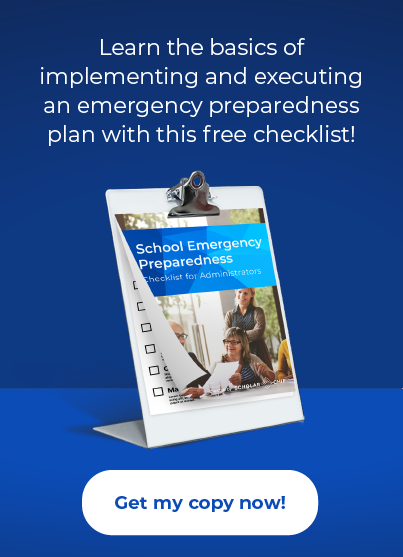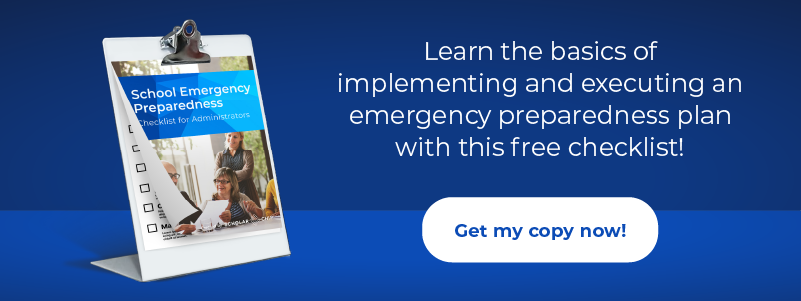Things are still up in the air about the school schedule in the wake of COVID-19. Whether your school will be returning full time, part time, or online, you must prepare students for the 2020-2021 school year.
While things will look different for students, it’s nothing compared to what administrators are facing. Fortunately, guidance for schools reopening in the fall has been provided.
Equally important to what administrators must do upon reopening is their plan for the experiences gained during the latter half of the 2019-2020 school year. COVID-19 has created questions for everyone, and while it’s not totally clear how things will change, that’s not a reason to delay planning. School safety planning and adjustments need to be addressed with the pandemic in mind.
Planning for Another Wave
As there is no vaccination available before the new school year starts, schools are faced with a hard reality: a second wave of the coronavirus could cause shutdowns similar to those experienced at the beginning of 2020.
Even if a second wave is less severe than the first, schools must understand that planning for a pandemic requires new thinking. Being unable to return to a regular, in-person school day and instead, having staggered schedules should bring into sharp focus the need for tools and strategies that address educational continuity.
Administrators need to start with an after-action review of what did and didn’t work in the final months of the 2019-2020 school year. This will help identify gaps and areas for improvement.
Start by asking questions about the strategies used. Did your distance-learning technologies work well? What problems occurred? How were they addressed, and how long did it take to do so?
What about your staff? Did they feel comfortable teaching remotely? Would more training help? Were they challenged by the technology or the solutions?
Of course, it’s also important to look at how students did during this time. Did grades fall? Were you able to tell when students were absent? How did students without access to computers or the internet maintain their education? How did special education classes adapt?
When starting the new school year, it’s essential to understand and evaluate any lapses in academic performance. Learning plans may need to be re-evaluated to accommodate an exaggerated “summer slide.” Solutions for these challenges need to be considered as part of your school safety planning for the new academic year, so appropriate adjustments can be made.
Planning for an Outbreak within Your School
Besides planning for a full-blown state-wide, national, or international pandemic, it’s also critical that you are prepared for a more localized infection outbreak.
Cues can be taken from your pandemic school safety planning on how to handle an infectious outbreak within your school. In particular, plans for how to maintain student learning while keeping students safe should efficiently translate from one to the other.
However, remote learning during the shutdown was done to prevent the spread of disease. In a localized outbreak, an infection may have already impacted a large population of students and staff. Your school safety planning must also take into account how to handle extended stretches where students are too ill to participate in any kind of educational activity.
Contingencies for missed learning time should be included in your planning. Communication will play a pivotal role. You must have a strategy and the right resources in place to keep parents and the community informed of the actions that your school is taking and what they should expect.
As part of your prevention and preparation for a localized outbreak, you should keep a close eye on attendance. Spotting trends in absences will inform your decision making on how to go forward and what parts of your school safety plan you should be initiating.
How Security Hardening Can Minimize Infection Exposure
Passing an infection from one student to another is undoubtedly a concern. Schools must also watch for any visitors (those without regular connections to the school) bringing illness onto the campus. Because students and staff have regular schedules within your school, it’s easy to identify when they are ill. Visitors, on the other hand, can spread a virus like COVID-19 throughout a school with little warning if they are allowed entrance to campus without restrictions.
Monitored access and locked exterior doors force visitors to enter the building at specific points, where staff can complete and enforce safety and wellness procedures. Limiting visitor access to the building by restricting them to the office or escorting them only to specific destinations further reduces risk.
Regardless of the strategies used to limit outside exposure, tracking visitors and contact information is crucial. A visitor management solution will allow the school to maintain contact with outsiders. This will simplify communication in the event of an outbreak.
The ways that schools handle catastrophic illnesses in the community is still evolving. Not all the answers for how to handle this are known. But that doesn’t mean schools cannot take action to protect students and staff. Plans should be made and then re-evaluated as updated data becomes available. School safety planning must take into account what has been learned in the last few months when dealing with COVID-19 and combining that with known safety solutions, all while being flexible and incorporating new information.
ScholarChip offers holistic school safety services aligned with CDC guidelines to help schools reopen amidst growing health concerns. Through our advanced technology, built and designed for the K-12 environment, schools can identify risks and mitigate the spread of infection. Our solutions include fever screening, visitor surveys, symptom and vaccine tracking, in-school contact tracing, alerts and notifications. Learn more about our advanced COVID-19 solutions or request a reopening strategy session today!


